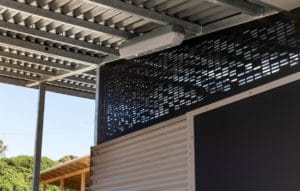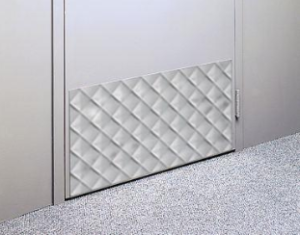How you can halve your project timeline with a modular building system
If you ask a Project Manager nicely, they’ll tell you the frustration that unexpected delays bring and their impact on the success of a project.
A variety of factors can throw out project schedules, some within our control and others that aren’t. Delays can be attributed to design alterations, weather elements, or variations to name a few.
As a general rule, it’s far more productive to focus on the elements you can control rather than those that you can’t.
Focusing on what we could control, ASCO developed the Stellar® modular building system to combat environmental factors and reduce installation complexities. Modular building systems simplify the installation process, whilst limiting room for errors and reduce the impact of external factors.
Why modular?
Our modular facilities are 100% assembled prior to being transported to site for installation.
Modular buildings offer more flexibility for customisation, whilst also being vandal resistant and low maintenance. They are simple to install, easier to maintain and provide a better user experience.
Not to mention the time saving; on previous projects, the modular buildings system has halved the project timeline.
So how exactly do they save time?
The modular building system can halve the project timeline, how is this possible?
While the site is being excavated and concrete is being poured, a modular facility is being fabricated in a controlled factory environment. Once site preparation is complete, the modular facility is ready to be sent to site for installation.


Each Stellar® building arrives to site 100% assembled and only requires a connection. This significantly limits time-on-site, reducing costs and potential OH&S logistics. The installation process can take from as little as 4 hours for a small single module to just a number of days for a large building. from start to finish. This is, of course, project dependant and larger, more complex facilities can take much longer to install.
The Case Study
Port Campbell, Victoria
Our Stellar® modular building system has given us the ability to deliver high-quality solutions whilst adhering to budgets, strict deadlines and geographical challenges.
In 2019, we delivered an accessible and culturally inclusive facility in Port Campbell, Victoria whilst adhering to a strict and limited deadline.

The Port Campbell community worked together to request and plan much-needed upgrades. The Shipwreck Park was undergoing a re-design including landscaping which would lead to increased foot traffic in the area.
As a result, the toilet facilities next to the park would require extensive upgrades to keep up with demand during the summer months, when they would see an influx of tourists.
The upgrades were to include a Changing Places facility, a number of squat pans as well as standard toilets all within the same facility. The timeline for this project was 3 months compared to the usual 6, which includes architectural design, structural design, drafting, and building permits, a process that in itself could take up to 6 months for regular traditional building methods.
Specifications:
The facility was designed to be inclusive and accessible for all residents and visitors, whilst being functional and low maintenance for Corangamite Shire. As such it would include;
Changing Places facility


The Changing Places facility was equipped with a changing table, hoist, privacy screen, large handwashing basin and handrails. Plus an extra-wide automatic door to suit access for all-terrain/beach wheelchairs.
This component of the amenities building can only be accessed with an MLAK key to ensuring it is only used by those who need it most.
You can learn more about Changing Places facilities, their features and requirements by reading our blogpost below:
“The 2020 Changing Places specifications and what they mean for your community”
Accessible Cubicle


This cubicle is wheelchair accessible and is equipped with handrails a baby change table, large handwashing basin and backrests. Any members of the public can access this cubicle without a key or permit required.
The complex also included a Parents Room containing two toilet pans divided by a partition and baby change facilities.
3 squat (European) cubicles


There were 3 Squat Cubicles within the facility with stainless steel pans to provide an option for users of different cultures ensuring their experience was as comfortable as possible.
2 ambient cubicles and 7 standard cubicles


The facility included X standard cubicles equipped with automatic stainless steel hand dryers and sharps disposal bins.
The result
Utilising the Stellar® modular building system resulted in significant time savings, this project would not have been completed on-time using the traditional site-building methodology. Without the use of the Stellar® modular building system this project would have taken double the time.
Modular construction meant that the facility was constructed offsite whilst demolition, drainage and concreting works were taking place on-site. Once the concrete was cured the building was ready to be sent to site for fixing and connection.
- Delivered to site in 4 modules on
- Installation was completed by a four-person team and the building was placed in one day
- The structure was completed in 3 days
- Fit-off to electrical and hydraulic services and floor coatings were completed after completion of the structure.
- Trades on-site included plumbers, concreters, carpenters and electricians.
This process resulted in a seamless operation which saw the building being ready in time for the grand opening of the upgraded precinct.
Since its opening, the facility has been heavily utilised by members of the public as well as tourists to the area.
Click here to learn more about our Stellar® range of public amenities buildings.
References:
Australian Bureau of Statistics (27 June 2017). “Port Campbell (State Suburb)“. 2016 Census QuickStats. Retrieved 28 January 2018.
Unique challenges require unique solutions (innovation)
We’re a team of problem solvers and innovators, we love finding solutions that solve public space challenges to bring communities together.
In 2019 Ausland Landscaping came to us with a unique project, to build an intricate shelter at Saltwater Estate in Point Cook. The structure had been designed by Prue Baulch and Hillary McLeish of Tract Consultants. It was unique and detailed, and we were excited to be part of such a bespoke project.
There was one key challenge that presented itself quite early in the design phase, stormwater treatment. The structure would consist of two large leaf-shaped roof structures which were to be stabilised by four columns, two columns for each leaf.


A central box gutter was required but hadn’t been addressed during the design phase. The addition of other elements would impact on the design intent and would ultimately detract from the intricate design of the structure.
Due to the location of the structure, a variety of weather conditions were expected throughout the year. Effective stormwater management was essential to ensure safety and durability.
The key question was: How do you stay within design guidelines whilst providing complex stormwater management?
Our solution: Incorporate the box gutter and downpipe into the fabricated structural members!
How we achieved it
Whilst managing stormwater, the four columns would also need to support the weight of the two structures. If the downpipe would be placed at the centre of each column, it would need to be executed to perfection or the structural integrity would be compromised. This was critical because the stormwater was draining out through a critical support column.
We ensured the structure would remain safe and the stormwater managed effectively by conducting a complex and detailed design analysis. This process involved the designers, engineers and fabricators to ensure there was no margin for error.
The below image shows the intricate designs which required the utmost precision.



To ensure the stormwater management would be effective, it was decided that the size of the columns would be increased. This would ensure they would be sturdy enough to support rainfall and the structures, regardless of the weather condition.
When working on bespoke projects like this, our primary concern is delivering on design intent. A considerable amount of time has gone into creating and refining the concept, so it’s essential to make sure it’s executed with the utmost accuracy.
“We invest time during the design phase because it has a direct impact on the construction program, quality outcomes and ultimately customer satisfaction.” – Matthew Earl, Co-Founder.
The end result
Our innovative approach allowed us to deliver on design intent and supply a product that we’re truly proud of. The planning and collaborative approach was integral to our success and ensured the everyone was happy with the end result.
Our extensive design process allowed us to accurately predict timelines and logistics. Ensuring the structure was erected in a timely manner to the satisfaction of architects, developers and head contractor.



You can see our ‘in progress’ Instagram post about the project below:
View this post on Instagram
This unique solution is one that we’ll think fondly of for many years to come.
To learn more about other elements of this project, you can read the overview here
As we’re preparing for what will be a busy and exciting year, we wanted to take some time to look back on our achievements from 2020.
Last year, as a business we grew, embraced challenges and came together as a team to solve problems for our clients and their communities.
We’re proud of all that the ASCO team achieved throughout the year, so we thought we’d share it with you too.
We expanded the Centaur® range to include off the shelf and flatpack options to serve more communities.
Knowing that not all communities want or need bespoke park furniture, in July we launched a range of off the shelf and flatpack park shelters. These structures were designed to be robust and customisable while being suitable for communities across the country.
Our announcement was met with a great deal of excitement from both our customers and industry partners!
Detailed information about the range including downloadable brochures can be found here.

We launched our new website and Newsletter.
In February, after much planning and preparation, we launched our brand-new website! Since then, we’ve continued to update it with articles, project overviews, product flyers and information.
Over the last 11 months, we’ve received some wonderful feedback and seen a wide range of visitors enjoying the site!
We also launched our newsletter ASCO News filled with industry and business insights, that has been very well received.
Missed out on the first two newsletters? You can sign up for future editions here.
We released the first edition of our Stellar® hardcover catalogue.
Early last year we created and released a comprehensive guide to our modular restrooms. This catalogue includes detailed drawings showcasing the different layouts and modifications available within our Stellar® range.
Interested in getting your hands on a copy? Reach out to Conrad our Business Development Specialist at conrad@ascogroup.com.au.

We moved to a larger factory.
As we grew, we knew we needed a bigger facility to enhance our manufacturing capabilities and keep up with demand. We also needed a bigger space to house our growing Sales, Accounting and Project Management staff.
In July, we moved from our North Geelong factory, into a 2000 square meter facility in Corio.
Want to pop in for a visit? We’re now located at 130 Broderick Road, Corio, Victoria, 3214.
Designed, fabricated and installed an iconic shelter in Wyndham Park.
We partnered with Ace Contractors to design, manufacture and install a 50-meter shelter in Wyndham Park! This structure was part of Wyndham City Council’s $13 Million infrastructure project to improve public spaces in the area.
The images really do speak for themselves.
You can read more about this spectacular project here.

Looking forward to 2021
As we look forward to the year ahead, we’re still committed to improving user comfort, safety and hygiene in public spaces. This is particularly important when it comes to public restrooms and Changing Places facilities.
We’re proud to have supplied such facilities in Greater Sydney, Regional NSW, South Australia, Greater Melbourne and Regional Victoria. We’re looking forward to making more communities comfortable this year.
Last but certainly not least, a big thank you to the whole ASCO team for your hard work and dedication throughout 2020! We’re looking forward to seeing what exciting projects and challenges 2021 has to bring!
Did you know that 4.2 billion people around the world are currently living without access to a safe and hygienic toilet?
According to the United Nations, the total world population is currently sitting at 7.8 billion, this means that 53% of the total population are without access to safely managed sanitation. It’s also worth noting that 40% of the population also don’t have access to basic handwashing facilities including soap and clean water at home.
If you find this information alarming, you’re not alone. These statistics largely come from third world countries where densely populated areas have limited access to resources and infrastructure.
Solving this sanitation issue requires innovative technologies and systems which are practical, cost-effective, and replicable on a large-scale. Key limitations are that toilets cannot run without adequate water supply, there are also challenges with sewerage treatment to consider. Even though a hygienic toilet should be available to everyone no matter where they live, it’s proved a challenging task for governments, charities and engineers for many years.

Image Source: UNICEF
Sanitation facilities are essential to public health
A key health concern for communities without adequate and sustainable sanitation facilities is the prevention and treatment of deadly infections such as COVID-19, Cholera and Typhoid. Even though a large portion of affected communities are in third world countries, all sanitation facilities are heavily reliant on adequate water supply.
Some parts of Australia suffer droughts year-round which limits their water supply. The Australian government effectively manages emergency water supply to prevent shortages which would see our sanitation facilities affected.

Image Source: United Nations ‘World Toilet Day’
World Toilet Day: Sustainable Sanitation
As part of their 2020 World Toilet Day campaign, the United Nations have indicated a need for more sustainable and eco-friendly sanitation solutions. The United Nations defines sustainable sanitation as a hygienic toilet that “captures human waste in a safe, accessible, and dignified setting’.
This year the United Nations are encouraging governments to allocate resources into the research and development of eco-friendly sanitation solutions. These facilities reuse waste to safely boost agriculture and reduce emissions for greener energy.
You can read more about the campaign and World Toilet Day here.

Image Source: United Nations ‘World Toilet Day’
What can you do about it?
Given that in Australia we have access to suitable water to run our facilities, a costly overhaul of all facilities to reuse waste is not required. However, there are some cost-effective modifications that will reduce running costs whilst limiting environmental impacts.
Fitting solar panels onto your toilet building
This involves a minor investment and can be installed on new and existing buildings saving on running costs for the facility. This small cost addition will result in long-term savings and would be best suited to buildings located in areas with ample sunlight.
Fitting sanitation station
This is also a minor investment and will reduce the facilities water usage, having this station installed outside the building will prevent the spread of germs when users exit the facility.
Installing LED lights
On average LED lights use 75% less energy and last 25 times longer than incandescent lights reducing energy consumption and reducing running costs.
Installing motion censored lights
Having motion censored lights will ensure that energy resources are not being used whilst the facility is empty. At a small investment, this feature will reduce energy usage and costs in the long-term, particularly during low-peak periods.
Want some more tips on how you can make your facility more energy efficient? Reach out to us, here we’re full of ideas!
Sources:
United Nations 2020, World Toilet Day 19 November, United Nations, retrieved 18 November <https://www.un.org/en/observances/toilet-day>.
United Nations 2020, Peace dignity and equality on a healthy planet, United Nations, retrieved 18 November, <https://www.un.org/en/>.
World ‘O Meter 2020, Current World Population, World ‘O Meter, Retrieved 18 November https://www.worldometers.info/world-population/#:~:text=7.8%20Billion%20(2020),currently%20living)%20of%20the%20world>.
This year has come with many unexpected changes for businesses and individuals worldwide, from restrictions to social distancing, to modified businesses operations, things are changing rapidly. These modifications have heavily impacted public spaces and how we utilise them, which is driving public space innovations.
A surge in foot traffic is driving change
Although the management of foot traffic was required to contain the virus, it has resulted in the temporary closure of a variety of public spaces. As these spaces begin to reopen, there has been an increase in usage from previous years. Recent data published by Google, highlighted the increased use of parks worldwide (Goodier M, Rayman, J 2020).
Given the surge in usage, we wanted to share our predictions for the future of public spaces. We also wanted to consider how the needs of the community may change over time so plans can be made for the future.
Some of our key areas of focus are:
- How can public spaces be conducive to social distancing and increased hygiene practices?
- What is the ‘new COVID normal’ and how will it impact our parks and facilities?
In this post, we outline our predictions and plans for design, functionality, and material use.
What spaces should be modified to improve hygiene?
A common practice for the foreseeable future will be social distancing, this will drive a variety of changes in how we live our lives and how we utilise public spaces.
Our list of important spaces to flag for upgrades or modifications are:
Public toilets
A common issue with public toilets is that if outdated or poorly designed, they can become a breeding ground for bacteria that can be difficult to control. There are minor improvements that can be made, however in some circumstances, significant upgrades are required.
While it may not be practical to replace or upgrade all facilities, there are some small low-cost changes which can be made immediately which will reduce risk and improve user safety. These include:
- Placing handwashing facilities outside the building, this will prevent users from touching doors and handles after they have washed their hands.
- Installing kickplates on toilet doors so users don’t have to touch surfaces after washing hands
- Ensuring soap dispensers are located at every public toilet
- Installation of automated hand sanitisation stations externally
Earlier this year, we published an article on key public toilet design considerations, it includes several hygiene suggestions. If you’re planning a new public amenities facility worth reading, you can find it here.
Hospitality Venues
The hospitality industry has suffered throughout the pandemic; with venues converting to offering take-away or contactless delivery only. This resulted in a significant decrease in revenue for these businesses, with some venues permanently closing.
One solution to this problem is Alfresco dining, otherwise known as outdoor dining or footpath trading. It allows patrons to dine outside the venue, decreasing the risk for community transmission in comparison with traditional indoor dining. This modification will benefit small businesses which are currently operating at a limited capacity. Outdoor dining also permits some venues to utilise previously untapped laneway space to provide dining or entertainment options for patrons.
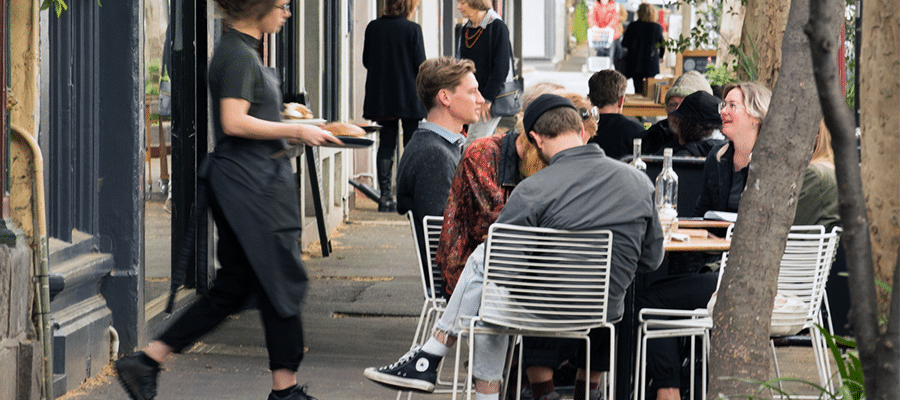
Image source: City of Yarra 2020
Earlier this month, it was announced that Piano Bar was converting Minns Place Laneway in Central Geelong into an entertainment venue. A great initiative, that will see the community able to celebrate music and entertainment once again.
We predict that we’ll continue to see innovations like this one as businesses and communities navigate their way out of lockdown. For more information on this project, you can read the full article by The City of Greater Geelong here.

For venues adapting outdoor dining, the infrastructure required will see streets putting pedestrian access ahead of car access. This will pave the way for retailers to expand their offering without being limited to their storefront.
Note: At the time of posting the Victorian government has just highlighted alfresco dining as a key strategy in the re-opening of the hospitality industry.
Playgrounds and Fitness Stations
Playgrounds are known to spread germs among children who can then unknowingly spread them to older members of the community. Some playgrounds and fitness stations will require significant design changes to prevent the spreading of germs within the community. There tend to be limited hand washing facilities near playground areas, this is an element we anticipate will change quickly.

Image source: ASCO Group, 2020
Currently, the onus is on parents to be equipped with hand sanitiser and wipes to ensure children’s hands are sanitised after playing. This can be difficult for visitors to the area, or for those making unplanned visits to the playground.
We predict state and local governments will take further steps to increase hygiene levels within these spaces to prevent further outbreaks.
Going forward, we’d like to see playgrounds fenced off, and fitted with sanitiser dispensers at entry and exit points, with access to the playground being granted upon use of the hand sanitiser. This would increase hygiene and safety standards for the children using these playgrounds.
Fitness stations are primarily used by adults, given that they tend to be spread out we expect to see an increase in hand sanitisation stations posted nearby. The onus will then be on the users to ensure they are sanitising their hands before and after use.
Public BBQ and picnic facilities
Public spaces with BBQ and picnic facilities attract heavy foot traffic during the school holidays and summer months. Communities are being encouraged to congregate outdoors as indoor spaces can increase the potential for transmission of the Corona Virus. As a result, these spaces are seeing an increase in demand as other spaces such as cinemas and indoor dining will be limited.
As congregating in big groups is being discouraged, we’re hoping to see parks establishing a variety of smaller picnic areas spread further apart. These smaller picnic areas can be defined with plantings and landscaping, creating zones within the park, benefiting the environment and the community. The below is an example of how cities could approach social distancing in heavily populated public spaces. The sectioning of picnic areas is being trialled in a variety of spaces throughout the world.

Image Source: Connected Places Catapult, 2020
Locally, this practice is being trialled at Customs Park in Geelong, Victoria on a slightly smaller scale. On September 25th the City of Greater Geelong announced it would be trialling circular markings in the 800 square meter grassed area to allow users to enjoy the park while maintaining a safe distance from others. You can find the offical announcement on their website here
The simultaneous sharing of communal picnic facilities between different groups will also decrease.
We anticipate changes being made to drinking fountains in parks and community spaces, there will likely be a decrease in demand for standard drinking fountains and an increased demand for bottle refilling facilities instead.
Pathways and trails
Due to restrictions, more people are conducting their daily exercise outside instead of at a fitness facility, resulting in an increased demand for pathways and trails. With some parks closed to prevent congregation, daily exercise has transitioned to walking, running, or cycling on local trails and pathways.

Image Source: ASCO Group 2015
Social interactions have also shifted towards going for walks with friends instead of going out or inviting them into your home, this has resulted in a surge of foot traffic on trails across the country. This surge could be in part due to the Australian Department of Health’s recommendations and suggestions for park-related activities on their website (Australian Government Department of Health, 2020). You can find their official recommendations on their website here.
As a result, we’ll see upgrades made to a variety of trails to meet the increased demand. These will include improved and expanded bicycle parking facilities and additional lanes with protection from vehicle traffic and more public amenities. There will also be the establishment of new trails and potentially the addition of fitness equipment, stretching stations and drink bottle refill stations.
Material changes
Many picnic tables and seats are constructed with materials such as timber, which can be difficult to sanitise and keep bacteria-free.

Image Source: ASCO Group 2016
As a result, we predict more communities will opt to use impermeable surfaces, which are much easier to sanitise than timber is. This will result in higher hygiene standards for those who use them, it will also simplify cleaning and maintenance processes of public furniture.
Materials such as anodised aluminium present an ideal solution. Given the Australian climate, surfaces which can become quite hot in summer. To ensure user comfort, a silver anodised surface will reflect heat, whereas a darker colour seat plank will absorb heat and become uncomfortable.
Things will change… but how quickly?
Long-term planning
Some of the anticipated changes we’ve highlighted will require significant infrastructure development, which can be costly and take time to plan and execute. In these areas forward planning and preparation is key, some of these projects may include:
- Replacement or establishment of public amenities facilities
- Re-design or replacement of playground areas
- Park refurbishments including landscaping to optimise communal spaces
- Pavement expansions to allow for alfresco dining and increased pedestrian thoroughfares
- Development of additional walking and cycling trails
- Extensive bus shelter upgrades
Although essential for the future these projects can be a significant investment, in some cases they can take 3-6 months to complete. There are however some cost-effective changes communities can make in the short term.
Short-term solutions
There are some solutions which can be implemented quickly with minimal investment and this may be all that’s required. In other cases, these modifications can act as temporary solutions until a more significant upgrade or investment can be made.
- Placing handwashing facilities external to each toilet building
- Fencing off playgrounds with sanitisation stations at the entry and exit points
- Installation of modular/temporary parklets that can be placed in car parks to convert them to alfresco dining areas.
Want specific advice on which changes your community will need?
You can reach out to us here, we’re here to help bring comfortable and practical solutions to your community.
References:
Australian Government Department of Health, 2020, ’Exercising and staying active during coronavirus COVID-19 restrictions’, retrieved 1 October 2020, < https://www.health.gov.au/news/health-alerts/novel-coronavirus-2019-ncov-health-alert/ongoing-support-during-coronavirus-covid-19/exercising-and-staying-active-during-coronavirus-covid-19-restrictions>.
ASCO Group, 2020, ‘Strathdale Playspace’, retrieved 30 September 2020, ASCO Projects, < https://ascogroup.com.au/projects/strathdale-playspace/>.
City of Yarra, 2020, ‘Footpath trading’, retrieved 30 September 2020, < https://www.yarracity.vic.gov.au/services/business-in-yarra/permits>.
City of Greater Geelong, 2020, ‘Piano Bar takes to the laneways’, Geelong Australia, retrieved 1 October 2020, <https://www.geelongaustralia.com.au/news/item/8d863905ebdea0e.aspx?utm_source=linkedin&utm_medium=orgsocial>.
Connected Places Catapult, 2020, ‘Innovation Brief: Post-Pandemic Public Space’, Medium, retrieved 16 October 2020, <https://medium.com/connectedplaces/post-pandemic-public-space-384302f9ba21>.
Goodier M, Rayman, J 2020, ‘Covid-19 is highlighting cities’ unequal access to green space’, CityMetric, retrieved 30 September 2020, < https://www.citymetric.com/fabric/covid-19-highlighting-cities-unequal-access-green-space-5168>.
The Project:
The Omega ™ Methodology has given us the opportunity to work on some incredible projects.
Last year we manufactured and installed a striking timber shelter at the Brickworks site in Burwood, Victoria.
Burwood Brickworks is home to the world’s most sustainable shopping complex, hosting 40 local and national retailers. The thoughtfully designed centre is located 14 km east of the Melbourne CBD and features outdoor play sculptures, open spaces, courtyard gardens and farm to table eateries.
The Burwood Brickworks site required a bespoke shelter to connect the outdoor and indoor spaces. This project was an ASCO favourite, due to the unique design and complexity of the structure.
Initial Designs:
Landscape architect Ed Billings from MDG Landscape Architects in Melbourne came up with the designs for the structure.
The Structure would be made from hot-dip galvanized and painted steel while the feature shade elements would be constructed from timber.

The timber ceiling being the feature, required the utmost care and precision without any room for error. Even the slightest deviation from the design would be obvious to the naked eye. This required a keen eye and meticulous attention to detail.
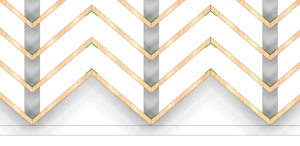
We were appointed by head contractor Peco Constructions to manufacture and install the intricate shelter. We were tasked with bringing the overall vision to life. The timber ceiling being intricate, and complex would have the biggest visual impact upon completion. It needed to be true to design but also stand the test of time both visually and structurally.

Our Process:
1. Drafting
The extensive drafting process required the resolution of clashes in materials. The design process included 6 sets of revisions to achieve the desired outcome. This process saw us working with the designer to make changes as required.
2. Modifications
The timber initially specified was 400mm x 75mm, however, the thickest timber available in kiln dried is 50mm. If the timber isn’t dried in a kiln it’s not as stable and can move, crack, twist and shrink.

With the timber being the focal point of the structure; we couldn’t risk deterioration as that would compromise the product. To resolve this issue, we chose to use smaller timber (290 x 45 mm) and lowered the ceiling joists by 100 mm to get the intended result both visually and structurally.
3. Testing
We hadn’t completed a project quite like this one, there was a great deal of planning involved to make sure it would live up to the designs. We created a few life-sized prototypes first to make sure the pattern would repeat and join as intended. Had we not taken these tests it would have been a significant investment and risk.

4. Fabrication
The fabrication was quite straight forward but required a lot of consideration when it came to methodologies used. To prevent any distortion in the steel or timber; the fabrication team planned and strategized to ensure every detail was considered.
5. Assembly and Installation
The steel was hot-dip galvanized and painted off-site, before being sent to site for assembly and installation. The roof was assembled on-site and then lifted into position.
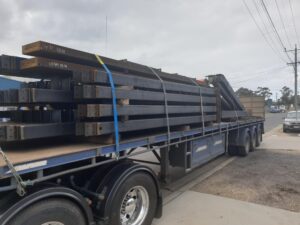

The installation was seamless, and it was rewarding to see all elements line up perfectly. The installation process was completed without any complications.

As always, communication was key. A collaborative process between the designer, architect, and project manager.
Finished Product:
The result was a stunning, intricate, and practical structure that will service the Burwood Brickworks community. Not only is this shelter beautiful to look at but it’s Australian made with high-quality local materials which will stand the test of time.
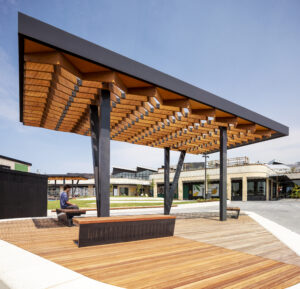
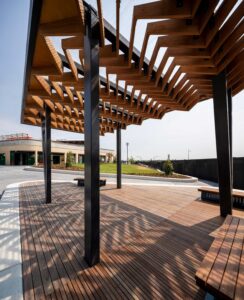
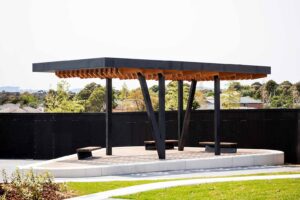
You can find more information about our Omega™ Methodology here
ASCO Group announces a new range of Centaur® park shelters available for purchase from 17 July 2020.
Known for their well-designed, premium quality public space solutions, ASCO group have announced that they will be adding to their Centaur® range of park shelters.
Launching today, the range will include three shelter models that can be supplied and delivered in kit form or installed on-site by ASCO.
The new range is designed to benefit communities Australia-wide, offering solutions to suit different weather conditions, locations design preferences and budgets.
The models in the extended range include:
C1000 – A robust, heavy-duty steel shelter made using high-quality timber cladding. Customisations to this model are included in the quoted price.
C2000 – A new all aluminium kit style shelter built to suit an array of weather conditions and locations, available in a variety of sizes.
C3000 – A durable and cost-effective skillion roof shelter made from galvanised steel and available in a variety of sizes.
All models within the Centaur® range will be available in a variety of sizes with different customisation options also available.
ASCO Group’s Business Development Principal, Matthew Earl indicated that these new offerings were designed due to a gap in the market “We created the new range because we believed that our local parks and playspaces were deserving of attractive and well-designed shelters. We believed that broadly, the products that are available do not meet these criteria”.
Unique features of the range include the ability to use custom colours bringing vibrancy to community spaces whilst providing councils with flexible installation options.
The new kit style shelters are available for immediate delivery, equipped with clear and concise instructions for simple assembly.
Speaking about the importance of material selection, ASCO Group CEO Lester Earl said, “Aluminium was our material of choice because of its strength and durability, and above all – up to 60% of the billet used for extrusion is from recycled product”.
The new Centaur® range is available for purchase from 17 July 2020. For further information and to request a quote visit ASCO’s website at https://ascogroup.com.au/ranges/centaur-range/
The Project Overview:
In late 2018, we were approached by Martyn Zdanius of Land Projects to supply and install a Stellar® S2020 Toilet Building at Epsom Reserve in Laverton, Victoria. This project was completed in August 2019 as part of a Hobsons Bay City Council redevelopment including renaming the reserve to Curlew Community Park.
This redevelopment was initiated after a thorough community consultation facilitated by Hobsons Bay City Council in 2015. Key considerations for the development were open spaces and pedestrian links.
The Particulars:
Location – Curlew Community Park, Epsom St, Laverton
Client – Hobsons Bay City Council
Landscape Contractor – JMAC Constructions
Landscape Architect – Martyn Zdanius, Land Projects
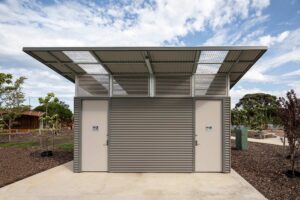
Council determined that a toilet building would also be required to accommodate the anticipated increase in usage due to the development. ASCO supplied a Stellar® toilet building from our S2020 range, equipped with two unisex stalls plus storage and service areas at the rear of the building to aid in the ongoing maintenance required.
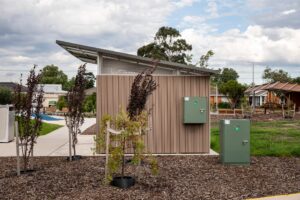
We were entrusted to bring the concept to life, with a cost-effective and durable facility, that met the ASCO standard. We developed the original concept and following that, constructed the building in our factory for transportation to site to complete the installation.
The initial 3D concept The final product


The materials:
The external cladding used in this building was compressed fibre cement panels. The sides of the building were clad with 40 x 30 mm of Enviroslat, a Wood Plastic Composite Batten. These materials were used to provide a low maintenance and cost-effective alternative to timber that won’t require ongoing treatment and therefore ongoing costs.
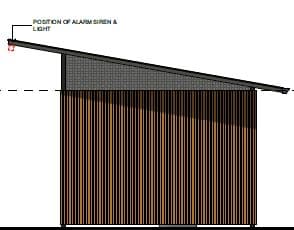
We took care to remove any gaps caused by corrugated cladding, in addition the use of flat internal cladding provided a stronger foundation for the sanitary and washroom fittings. Both measures ensure long-term cost savings due to lower ongoing maintenance costs.
The challenges:
Whilst there were challenges on site relating to the soil conditions, the Stellar® S2020 toilet building was delivered and installed on schedule, without any unexpected costs or time delays.
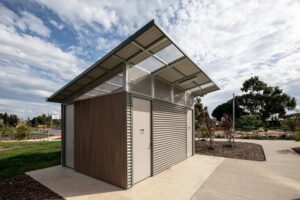
The mural:
A distinctive feature of this toilet building is the mural on the rear of the building. The council was looking for a design that would reflect the natural environment of the area and contracted Melbourne based artist Ness Flett. Ness has completed a variety of artworks for local councils and came highly recommended.

Prior to Ness painting the mural, the wall was prepared with a base coat and after the mural was complete an anti-graffiti coating was also applied for further protection.
It was this mural that inspired the renaming of the park from Epsom Reserve to Curlew Community Park. The name references the Curlew Sandpiper, a medium-sized shorebird that frequents wetlands in large flocks.
The result:
The final product was the result of a meticulously planned and collaborative approach between all contractors involved. We’re proud to have been part of such an important development that will benefit the community and their new public space for years to come.
In December 2019, a celebration was held to officially open the new and improved community space.
Have any questions about this project? Contact us at media@ascogroup.com.au
Don’t want to miss out on our updates? Sign up to our mailing list here
You can find more information about our range of Stellar® S2020 Toilet Building’s here
The design and installation of a public toilet building is complicated, there are many small details that have a large impact. Variations are stressful, result in unbudgeted costs and time delays, all of which can put the entire project into jeopardy.
To make the design process easier to navigate, we’ve put together a list of 7 things to consider when planning your next public toilet building.
Placement
First things first, where are you going to put your toilet building? What direction will it face?
The placement is incredibly important and must be very carefully thought out. Unfortunately, there is no ‘one size fits all’ solution and there are many factors to consider.
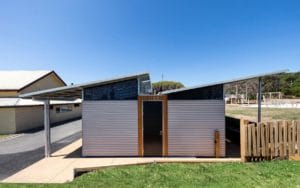
The best thing you can do is seek advice from an expert at the beginning of your project. If your facility isn’t strategically placed, it can cause project delays and result in significant additional costs and unexpected variations down the track. We’ll take a deep dive into this in a future blog post.
Ventilation
How many times have you been into a public toilet and had to cover your nose because of the smell? Chances are, there were a few issues at play, one of them being adequate ventilation.
An essential element to consider is that your toilet building will have ample ventilation, this can be either natural or mechanical. The circulation of fresh air is essential, as it evacuates airborne germs and diseases whilst maintaining hygiene levels for users. Ventilation helps odour to escape ensuring a more comfortable user experience.
Building material selection plays a big part here. Where timber is used in construction of ‘wet’ rooms like these, it absorbs and retains odour as well as adding odours of dampness and decay over time.
Surfaces
A common concern we hear is the ongoing cleaning and maintenance of public toilet buildings. In order to meet and maintain hygiene and safety standards, it costs councils time and money.
Did you know that the materials and surfaces chosen can also have a significant impact on the cleaning and maintenance of these facilities?
What surfaces should you be looking for?
Flat internal cladding has a smaller surface area than corrugated cladding (pictured below), meaning there is less surface area to clean, this results in a reduction in ongoing cleaning and maintenance costs. This material repels bacteria and dirt such as Polymer, Composites and Metals, making it easier to clean and more hygienic for users. This is why it’s our preferred choice and what we recommend to our customers.

What are some materials and surfaces that you should be staying away from?
At the top of your list of things to avoid should be tiles and corrugated surfaces. Tiles can be problematic as the grout is known for absorbing dirt. Whereas corrugated surfaces also create spaces where dirt, insects and rubbish can gather.
Hand Washing
A key concern when it comes to public restrooms and amenities buildings is hygiene. What are some simple steps you can take to ensure your facility is as hygienic as possible?
Handwashing is a great place to start. Traditionally handwashing facilities have been located within the building itself. However, it’s worth considering having your handwashing station placed outside the toilet. Allowing users to wash their hands after exiting, eliminating the need for users to touch any doors, post handwashing, where they could potentially transfer or pick up germs.
This station should be equipped with an alcoholic hand sanitiser dispenser, offering a simple alternative. This eliminates the need for a hand dryer or paper towel making it cost-effective and environmentally friendly.
Seat sanitation
Did you know that toilet seats can carry 50 bacteria per square inch?
To minimise the transfer of this bacteria, it’s worthwhile installing a seat sanitiser dispenser or wipes so users can clean the seat prior to use.
This is an added measure to ensure hygiene is maintained whilst providing users with peace of mind.
Doors
In recent years, there have been a variety of changes to doors in public restrooms, including the introduction of automatic doors. Many of these automations have been to improve hygiene standards. In some cases, a button still needs to be pressed to open the door, which minimises the effectiveness of these automations.
Instead, consider an outward opening door with a stainless-steel kick plate. This allows the user to exit the toilet building with minimal contact, preventing the transfer of bacteria.
Technological Innovations
You’ve sorted out the placement and materials for your facility, now you can move onto the user experience. Sensor technology can play a part in ensuring your facility is as hygienic and efficient as possible.
Additions such as sensor-operated flushing, hand washing, soap dispensing and hand drying all assist in providing a touch-free experience. Minimising the touchpoints within a toilet building plays a vital role in maintaining hygiene standards.
Even if you’re designing a touch-free facility, we still recommended installing your handwashing station outside the building to guarantee users will be germ-free after leaving the premises.
We hope you found this helpful and will help in your future planning.
There are of course many other elements to consider which we will touch on in future posts.
You can find out more information about our Stellar® range of public toilets and amenities buildings here.
Stay in touch
To make sure you don’t miss out on future updates and articles, follow us on LinkedIn here.
You can also sign up for our newsletter here.
